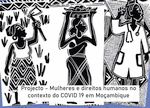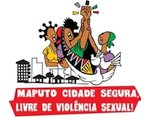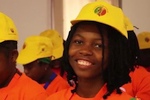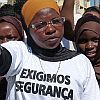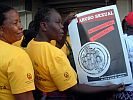Gender and Democracy
Conceição Osório
This article is based on research that was carried out in the provinces of Maputo (Matola and Manhiça districts), Nampula (Nampula city, Moma and Ilha de Moçambique districts) and Sofala (Beira city, Gorongosa and Nhamatanda districts), places considered representative of the South, North and Centre of Mozambique, respectively, during the campaign for the 2009 legislative and provincial elections.1
The title Gender and Democracy refers to the object of the research, access to and exercise of power by women, through an analysis of the electoral processes that took place in 2009. It was considered important to show and to contextualise the influence that the democratic system has on the inclusion of women into the political field, in particular how the way in which women exercise citizenship, bringing new topics and new actors to the political debate, can be a factor in the renovation of democracy.
Fifteen years after the first legislative and presidential elections took place in 1994, the study intended to update certain questions that, not having been examined in depth before, constitute key elements in the understanding of the access to and exercise of power in a democratic context, as in the case of the public gender policies and strategies that were defined during the last legislative period by the government’s programme, the commitment of civil society to equal rights, and also the strategies and actions of the political parties, not only through the inclusion of women in the lists of candidates running for election, but also in terms of the power relations within the three political parties that were the object of the study (MDM, Renamo and Frelimo).
The election campaign, as reflected in radio and television broadcasts by the parties and in the rallies and other forms of appeals to vote, as well as the way the press expressed the intentions of the parties, formed an important element in the research, in order to identify the intersections of programmes and the narrative used in discourse with a conception of rights based on gender equality.
To meet the intended goals an analysis was made of the legal provisions and institutional mechanisms that embody public policies, including the main legislation guiding the electoral processes, the programmes, charters and election manifestoes of the three parties and also the speeches of a total of 104 interviewees. In addition to candidates, male and female, we interviewed civil society activists that monitor the state of democracy in Mozambique, in order to identify perceptions of inequality between women and men and the impact these perceptions have on the actions they undertake. The research was carried out in four constituencies for the legislative elections and in seven for the provincial elections.
In spite of the difficulties encountered in carrying out the research (e.g. the excessive secrecy of information that should by law be public, as in the case of access to the lists of candidates, and the unusual way the National Electoral Commission interpreted its leading role before and after the elections), we felt it would be more useful for a better understanding of the study to formulate four questions that can shed light on the proposals and practices regarding gender equality. Those questions are the numerical indicators that show how the positions of power are presently distributed between men and women, the public policies aiming to promote gender equality, the programmatic documents of the parties and finally the utterances of the candidates we interviewed.
Data from the National Statistics Institute (in 2008, for the first time, numerical indicators were developed that help to understand the situation of women in employment but also in sectors such as health and education) show an increase in the number of women in the organs of political decision, being particularly relevant the numbers in the National Assembly (“Assembleia da República”; parliament) in civil service and in the organs of community involvement.
While in the first legislative period, in 1977, the number of women in the legislative body was only 12%, in 2010 that had grown to 39.6% (in the present legislative period the president of the National Assembly as well as the leaders of two of the three parties in parliament are women). The access of women to decision-making positions, both in civil service – especially at the level of senior State management functions – and in the central party organs, has grown, reaching sometimes levels above 30%2.
Although those numbers are very stimulating, if we take as an example the local authorities and the district administrations, the disparity is still significant. Taking into consideration that these are realms of power of high visibility and proximity to the communities, these discrepancies, that show an unequal distribution of power, could mean an attempt to reconcile a political intention of equal rights with a cultural status (thus pleasing the conservative local elites) that perpetuates discrimination.
As far as policies are concerned, considering the advances recorded in recent years in Mozambique and in the wake of what is happening in the SADC, we note the existence of public policies committed to equality between men and women. In 2005 a gender policy was approved, mechanisms for its implementation were created and new legislation was developed, like the laws against trafficking and, more recently, against domestic violence, that formally represent a commitment of the county to the struggle for women’s human rights. The crosscutting nature of the gender issue in the sector policies and the creation, in 2005, of the Office of Female Parliamentarians, constitute mechanisms that, although at different levels of intervention, can lead to positive practices in favour of gender equality.
However, our research indicates that this commitment to equality between women and men is being limited by the insufficient dissemination of the strategies, by difficulties with the articulation between sectors, difficulties in budgeting and in monitoring and evaluation and further by the absence of regulation of legal provisions. These circumstances hinder, or even prevent, the implementation of the gender policies at the level of local government, of the courts and of all the institutions whose duty it is to assure that Governmental directions are being enforced.
For this reason, the commitment to establish gender policies still coexists in the political discourse, in the deliberations of institutions and in social practices, with the preservation of roles that underlie the patriarchal model. This model, while restricting women’s human rights to cultural references, recreates gender hierarchies and separates the private from the public, “naturalising” the structure of domination. That’s why today we find complacency and impunity towards the violation of women’s human rights, as in the case of sexual harassment, domestic violence (just to give one example, even today, in October 2010, in a police station in Maputo, an obvious case of domestic violence was treated as a private problem) and we still stand by with impunity when children are forced into unions with adult men – what some people persist in calling child “marriages”.
Complacency, if not connivance, with the violation of women’s rights, is also present in the ambiguity in the discourse of many of the men and women we interviewed, that becomes apparent not only in the absence of references to women’s rights, but also in the insistence on an essentialist view of women’s roles. In other words, the recognition of women’s human rights is almost always conditioned by her membership of the group, as mother, spouse and educator. This negation of women as subjects of rights, in our case supported by arguments in defence of “our culture”, raises doubts about the political statements that appear in the equality policies. And this situation is all the more surprising when one doesn’t take into account that the cultural dynamics that have an effect on the tradition, are, whether we like it or not, challenging cultural practices that are exercised against women. In Manica, for example, there are 12 year olds that run away to other provinces when their parents take them out of school to deliver them to men to whom they have been promised as children; another example is the conservative accusation that “nowadays people marry in the street” when referring to youths who do not want to subject their unions to family alliances and dependencies.
As for civil society, it has to be pointed out that, for the first time in the history of the country since it became a democracy, an agenda for the political inclusion of women has been adopted. However, in the interviews held with members of those organisations – although their positions vary – we observe in many of them (women’s organisations as well as those that monitor the democratic process) a tendency to stress the formal aspects of access to power, conditioning the exercise of rights to the preservation of a culture of exclusion.
In the case of the political parties that we studied, and although it is impossible to ignore the differentiated contexts in which they were formed, what is clearly stated in their guiding documents is a position of consensus in relation to the existences of a system of quotas as an expression of their commitment to equality between women and men. Similarly, the documentation that set outs the policies of some of the parties abounds with references to the promotion of women to resources, particularly access to education, to employment and to power. However, even those parties which are most committed to equal rights and to the crosscutting nature of gender inclusion, have programs that limit the definition and the scope of women’s human rights. While their party manifestoes talk about equality, at the same time this equality is subjected to a cultural tradition that is conceived as static and unchangeable.
This situation matches the fact that the quota system constitutes the main (and almost the only) strategy – and even, slightly ironically, a confortable strategy – used by the majority of political parties to promote women’s rights. This leads to a situation in which the means to achieve gender equality hardly go beyond the distribution of seats, thus reducing it to a formal procedure of access to positions of command. This, in fact, is a stimulus for the structure of inequality to remain hidden, leading to a certain male complacency with what is considered the incompetence of women to access decision-making positions without “help” (in contrast with what happens “normally” with men). This attitude of condescension toward women also shows itself in the distribution of resources within the parties, with manifestations of discrimination, in which the symbolic dimension becomes particularly relevant, as happens with the use of stereotypes, whenever the distribution of power is at stake.
The ambivalence in the party documents recurred, in a way, in the interviews, especially when trying to verify the existence of a gender agenda. Nevertheless, it is very interesting to note that the resistance to the occupation of the political field by women, as it was transmitted in preceding years by a certain political discourse and by a public opinion that classified political action by women in agreement with the stereotypical attributes, today no longer has the same symbolic “strength”. One of the consequences of this phenomenon is that during the 2009 elections the political parties, through their – male and female – leaders and candidates, mentioned democratic principles as the ones that guided the selection of candidates, without distinguishing male and female characteristics, stressing the role of the local party organs in the composition of the lists.
This does not mean, however – as the study shows clearly – that what is classified as female attributes no longer plays a role in organising the division of political labour, as becomes evident in many discourses that pin down the female identity to mobilisation, sacrifice and the pacification of conflicts. The election campaign is an example of how the visibility of women in all activities undertaken by the parties analysed in this study was not translated into a more prominent role in the radio and TV broadcasts or in the press3. Sent off to a sort of “limbo”, the voices and the rights of women somehow remained in the dusk, silenced or/and reduced to their role as mobilisers, mothers and educators.
This ambivalence in positions and roles at the same time harmonises a discourse that combines democracy in the party (conditioned by political clientelism and by party discipline) with discrimination in the family, without this being seen as producing inequality.
When analysing access by women to positions of power inside the parties, the majority of men and women that were interviewed mention equal rights between the sexes and bring up components like competence, loyalty and having proven oneself as the main elements that determine the access to places of power – for women as well as for men. What can be observed however, among men as well as women, is that – in spite of some changes recorded during the last legislative period, reflected, for example, in the demand for more time to address the assembly (understood as a right) – there is still a relation of subservience in relation to party comrades and to affective partners.
In this context, when trying to understand how the transfer of democracy in the party to the relations developed in the conjugal sphere takes place, we were surprised to find that, for men, but also for some women, democracy in the party is in tune with discrimination at home, insofar as the role and functions of women are understood and felt as subordinate. However, some of the women and even some of the men (although in smaller numbers) we interviewed, clearly identify the transfer of subordinate gender relations from the family to the party. What is interesting in the utterances of some of the female candidates of the three parties – showing that something has changed since 2004 – is that approximately 20% of all female candidates identify the origin of gender inequality and of its reproduction in the political realm, while at the same time demanding rights and indicating ways to build an agenda to defend the rights of women.
Therefore, when comparing the 2009 legislative elections with earlier electoral acts, one notes evident signs of progress in the political parties with regard to access to power by women. Although the women’s organisations of the different parties have not yet asserted themselves by developing a gender agenda that subverts the codes that structure the political field, during those last years a consensus between parties was created about the need to include women as a way to change the sharp disparities in the occupation of positions of power. Even though parties are not mobilised for this strategy as a way to change power relations, one notes that the presence of women exposes conflicts and triggers demands that favour the construction of a gender conscience.
That’s why nowadays there are more female party militants and leaders that break with the model of vulnerability and victimisation, denouncing the democratic deficit that exists within the parties. These women rebel against cultural values that, in the public as well as in the private realm, prevent them from being the subjects of rights and they demand that the visibility that is granted to them, in the activities of the election campaign, for example, be reflected in the distribution of power.
These new practices could also be related to the rejuvenation within some of the parties and especially with a change in the factors of cohesion that structured the hierarchies and the political action, transforming them into “civil and modern” parties, guided by democratic principles.
However, the study shows that the process of democratisation of the parties, particularly the greater inclusion of women, is not simple or linear, because if, on the one hand, we are witnessing an attempt to develop provisions that regulate political interaction, on the other, there are manifestations of intolerance, of which the last elections are an example, through new forms of a vanguardist discourse that considers the “other” as the enemy. The political violence that was visible during the election campaign, of which the book gives ample illustration, shows a weakening of the democratic system that does not stimulate the exercise of civil and political rights.
In the same way and particularly in relation to women’s human rights, although certain signs of change can be found, what is still prevailing is a view of rights that perpetuates inequality, resorting to cultural references to justify male domination. It is this culture that, producing (and reproducing) gender violence, transforms itself, especially in the last years, into a source of legitimation to curb the struggle for equality between men and women.
The ambiguities between conceptions and between different practices that we tried to analyse in our research, are signs of the contradiction that the State, the political actors and civil society will have to consider. For example, the fact that Mozambique occupies one of the first places in the ranking of the number of female MPs, while at the same time being one of the ten countries where the practice of the so-called child marriage is most common. Also, almost daily we witness the impunity of the crimes committed against women (the so-called hate crimes), (e.g. recently, in October 2010, in the province of Zambezia, around 17 women were lynched in public, for being accused of witchcraft), without any immediate reaction from the State, from the female members of Parliament or from civil society. This deafening silence is becoming worrisome.
For the culture of violence to be substituted by a culture of rights, the government and the civil society organisations need to develop, as proposed by the UN agency UNIFEM4, counter-cultural policies as a way of removing the obstacles that structurally block access to the exercise of women’s human rights.
Finally, the study shows that it is decisive for the survival of the democratic system that the parties transform themselves into key spaces of inclusion, establishing themselves as institutions that allow plurality. Preventing the reduction of the individual to the party collective by suffocating the difference, the conditions will be created for the affirmation of rights in the public realm and their projection into the family. That’s how the inclusion of women in the political field, by linking together quantitative and qualitative equality, can produce what some authors call “unprecedented and subversive equality” or, in other words, the “transformation of the parties in feminist institutions”, in the sense that their militants commit themselves to the struggle for gender equality.
- Published in full in the book “Género e Democracia” (Gender and Democracy), launched on 12 November, 2010.
- The percentage of women in the central party organs is for Frelimo 35% in the Political Commission and also 35% in the Central Committee. In Renamo women constitute 40% of the members of the Political Commission and 42% of the National Council. In MDM the percentage of women in the Political Commission was 18% when this study was being carried out, but has now gone down to 9%.
- Our study shows that only 10% of radio and TV broadcasts and of speeches during the rallies had women’s rights as a topic, and even that small part was mostly in consonance with the patriarchal model.
- UNIFEM (2009), Who Answers to Women? Gender and Accountability.







 Information in English
Information in English